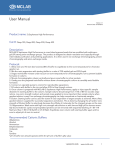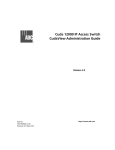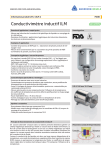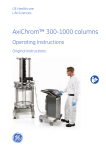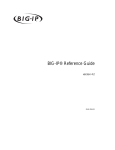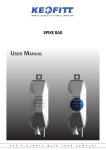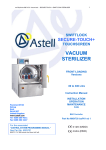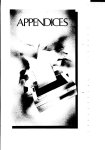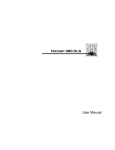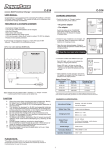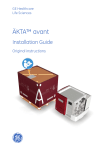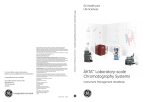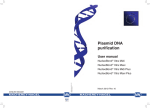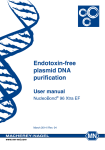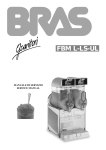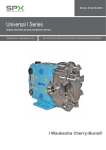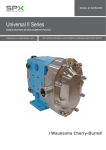Download ReadyToProcess columns User Manual
Transcript
ReadyToProcess™ columns User Manual Page intentionally left blank Table of Contents Table of Contents 1 Introduction .......................................................................................................... 5 1.1 1.2 1.3 About this manual ................................................................................................................................ Important user information ............................................................................................................. Regulatory information ...................................................................................................................... 6 7 9 Safety instructions ............................................................................................... 10 2.1 2.2 2.3 Safety precautions ............................................................................................................................... Labels ......................................................................................................................................................... Recycling information ......................................................................................................................... 11 14 15 Column description ............................................................................................. 16 3.1 3.2 General description ............................................................................................................................. Illustration ................................................................................................................................................ 17 20 Installation ............................................................................................................ 21 4.1 4.2 4.3 Unpacking ................................................................................................................................................ Storage ...................................................................................................................................................... Start using the column ....................................................................................................................... 22 24 25 5 Affinity chromatography resin .......................................................................... 27 6 Ion Exchange (IEX) chromatography resins .................................................... 30 6.1 6.2 6.3 6.4 6.5 Capto S and Capto Q .......................................................................................................................... Capto SP ImpRes and Capto Q ImpRes ...................................................................................... Capto S ImpAct ...................................................................................................................................... Sepharose Fast Flow IEX resin ........................................................................................................ Sepharose High Performance IEX resin ..................................................................................... 31 33 35 37 39 Multimodal chromatography resins ................................................................. 41 7.1 7.2 Capto adhere and Capto MMC ....................................................................................................... Capto adhere ImpRes and Capto MMC ImpRes ..................................................................... 42 45 8 Hydrophobic Interaction Chromatography (HIC) resins ............................... 48 9 Operation .............................................................................................................. 52 9.1 9.2 9.3 9.4 9.5 Connect the column ............................................................................................................................ Clearance of storage solution and equilibration of the column ..................................... Regeneration of the column between purification cycles ................................................. Disconnect the column prior to disposal ................................................................................... Evaluation of the packed bed (optional) .................................................................................... 53 55 56 57 58 10 Troubleshooting ................................................................................................... 62 2 3 4 7 ReadyToProcess columns User Manual 28-9256-44 AE 3 Table of Contents 11 Reference information ....................................................................................... 11.1 11.2 11.3 11.4 11.5 4 64 Specifications ......................................................................................................................................... Chemical resistance ............................................................................................................................ Wetted parts ........................................................................................................................................... Flow conversion tables ...................................................................................................................... Ordering information .......................................................................................................................... 65 66 68 69 71 Index ....................................................................................................................... 80 ReadyToProcess columns User Manual 28-9256-44 AE 1 Introduction 1 Introduction About this chapter This chapter contains important user information, descriptions of safety notices, regulatory information and intended use of the ReadyToProcess™ columns. In this chapter This chapter contains the following sections: Section See page 1.1 About this manual 6 1.2 Important user information 7 1.3 Regulatory information 9 ReadyToProcess columns User Manual 28-9256-44 AE 5 1 Introduction 1.1 About this manual 1.1 About this manual Purpose of this manual The User Manual provides you with a general introduction and guide to ReadyToProcess column operation. Typographical conventions Software items are identified in the text by bold italic text. A colon separates menu levels, thus File:Open refers to the Open command in the File menu. Hardware items are identified in the text by bold text (for example, Power). 6 ReadyToProcess columns User Manual 28-9256-44 AE 1 Introduction 1.2 Important user information 1.2 Important user information Read this before using ReadyToProcess columns All users must read this entire manual to fully understand the safe use of ReadyToProcess columns. Intended use of ReadyToProcess columns ReadyToProcess columns are designed for purification of biomolecules and may be suitable for production of material for clinical phase I and phase II studies. Depending on the scale of operations they may be suitable for full scale manufacturing as well as preclinical studies. ReadyToProcess columns are recommended for upflow mode and primarily intended for use together with ÄKTA™ ready chromatography systems. The ReadyToProcess columns can also be used with the standard systems ÄKTAprocess™ and ÄKTApilot™. WARNING The ReadyToProcess columns must not be used for any other purpose than the intended use described in the User Manual. WARNING: EXPLOSION HAZARD The columns are not approved for work in a potentially explosive atmosphere, in areas classified as Zone 0 to Zone 2 according to IEC 60079-10 2002. The products do not fulfill the requirements of the ATEX Directive. Disposal When the column has been used it shall be disposed of as described in Section 2.3 Recycling information, on page 15. The ReadyToProcess columns cannot be repacked. ReadyToProcess columns User Manual 28-9256-44 AE 7 1 Introduction 1.2 Important user information Safety notices This user documentation contains safety notices (WARNING, CAUTION, and NOTICE) concerning the safe use of the product. See definitions below. WARNING WARNING indicates a hazardous situation which, if not avoided, could result in death or serious injury. It is important not to proceed until all stated conditions are met and clearly understood. CAUTION CAUTION indicates a hazardous situation which, if not avoided, could result in minor or moderate injury. It is important not to proceed until all stated conditions are met and clearly understood. NOTICE NOTICE indicates instructions that must be followed to avoid damage to the product or other equipment. Notes and tips 8 Note: A note is used to indicate information that is important for trouble-free and optimal use of the product. Tip: A tip contains useful information that can improve or optimize your procedures. ReadyToProcess columns User Manual 28-9256-44 AE 1 Introduction 1.3 Regulatory information 1.3 Regulatory information Regulatory product documentation Each ReadyToProcess column is accompanied with an extensive documentation package to help customers register a production process in a GMP environment containing a chromatography step including a ReadyToProcess column. The columns are validated both in terms of performance criteria, stability and sanitization design and use materials classified according to current regulatory guidelines specified on the materials. The documentation is divided into three parts. • Product documentation: Certificate of conformance is provided, showing conformance with 21CFR177, USP Class VI, and animal-free origin (or EMEA/410/01) for each wetted part material. The certificate of conformance also shows traceability of the materials. The product documentation contains a certificate of analysis showing packing performance as well as endotoxin and microbiology test results for the delivered column. The documentation is delivered with each column and the certificate of analysis can be downloaded on the web at www.gelifesciences.com/certificates. • Validation guide: Validation guide gives access to product information of the ReadyToProcess column, including stability and quality, as well as a brief description of the preparation. • Regulatory Support File (RSF): Current files include additional information on each BioProcess™ chromatography resin. RSF addenda and RSF are available at www.gelifesciences.com/rsf. Materials The polymer materials used to manufacture ReadyToProcess columns have been chosen for their biological and chemical compatibility with the samples, buffers and solutions used during operation and during sanitization procedures. The materials comply with the FDA Title 21 CFR 177 and the USP (United States Pharmacopeia) class VI requirements according to USP <88> Biological Reactivity Tests, “In Vivo”. The material is of non-animal origin or has been produced under manufacturing conditions complying with EMEA/410/01 guidance. The columns are designed to comply with hygienic requirements. For a list of the wetted parts, refer to Section 11.3 Wetted parts, on page 68. ReadyToProcess columns User Manual 28-9256-44 AE 9 2 Safety instructions 2 Safety instructions About this chapter This chapter describes safety precautions, the column label and information regarding disposal of the column. In this chapter This chapter contains the following sections: Section 10 See page 2.1 Safety precautions 11 2.2 Labels 14 2.3 Recycling information 15 ReadyToProcess columns User Manual 28-9256-44 AE 2 Safety instructions 2.1 Safety precautions 2.1 Safety precautions General precautions The columns must be used in accordance with the safety instructions and technical specifications given in this User Manual to avoid personal injury or possible damage to equipment. This User Manual does not guarantee user safety – it is the responsibility of the user's employer to ensure safe operation and provide appropriate training. Information given in this User Manual is a suggested best working practice and shall in no way take precedence over individual responsibilities or local regulations. Great effort has been made to design and manufacture the various parts of the equipment so that it will comply with all applicable safety aspects for this type of equipment. During the operation and during other work with a column, it is always each individual's responsibility to consider: • their own and others' personal safety. • the safety of the equipment through correct use in accordance with the descriptions and instructions given in this User Manual. Flammable liquids and explosive environment WARNING: EXPLOSION HAZARD The columns are not approved for work in a potentially explosive atmosphere, in areas classified as Zone 0 to Zone 2 according to IEC 60079-10 2002. The products do not fulfill the requirements of the ATEX Directive. ReadyToProcess columns User Manual 28-9256-44 AE 11 2 Safety instructions 2.1 Safety precautions Personal protection WARNING When using hazardous chemical and biological agents, take all suitable protective measures, such as wearing protective glasses and gloves resistant to the substances used. Follow local and/or national regulations for safe operation and maintenance of ReadyToProcess columns. Installation and moving WARNING Appropriate transportation and lifting devices must be used when handling the larger columns, for example carts, telphers or pallet lifters. All lifting must be performed in accordance with local regulations. Two to four persons are required to lift the larger columns manually. WARNING Place the column where it is protected from possible damage and on an even surface where it cannot be unbalanced and fall, to avoid personal injury or damage. WARNING To avoid risk of possible personal injury and damage to the column and other equipment, never use the column without an appropriate pressure alarm. WARNING Do not disconnect or release the CPC sealing cap, remove the tie rods or the protective rim. Do not remove the welded tubing attached to the column inlet and outlet until the column is ready to be connected to a system and used. 12 ReadyToProcess columns User Manual 28-9256-44 AE 2 Safety instructions 2.1 Safety precautions Column operation WARNING Do not operate ReadyToProcess columns in any other way than described in the User Manual. WARNING Never exceed the maximum rated pressure of the column. WARNING Make sure that there is no residual pressure in the column before any tubing is disconnected. WARNING Wash the column before disconnecting it from a system after use to ensure that no hazardous chemicals (for example halogencontaining salt buffers) are left in the column prior to disposal. WARNING Wash/wipe off any NaOH residue from the surface of the column. ReadyToProcess columns User Manual 28-9256-44 AE 13 2 Safety instructions 2.2 Labels 2.2 Labels Column label The column label contains the product name with information about the preservative and if it is flammable. There are also information about maximum operating pressures and temperatures. Note: The information on the left part of the label is described in the table below. Label No 28916857-AE 28-9017-14 2.5 l column Lot 20140630 Expiry 2014-06 Id No. 20140630 Store at +4 to +30°C GE Healthcare RTP Capto™ adhere 2.5 contains 20% ethanol as preservative Max Operating Pressure: 4 Bar Max Operating Temperature: 30°C MADE IN SWEDEN Warning GE Healthcare Bio-Sciences AB SE-751 84 Uppsala, Sweden +46 18 612 00 00 www.gelifesciences.com Flammable liquid and vapour. Keep away from heat/ sparks/ open flames/ hot surfaces. – No smoking. Keep container tightly closed. Wear protective gloves. Store in a well ventilated place. Keep cool. Label text Description Article number Article number for the column. Column size Column size which can be 1, 2.5, 10, or 20 L. Lot Lot number. Refers to a column produced at a specific time. The lot number and ID number ensures that the ReadyToProcess column is fully traceable to the production source. 14 Expiry Estimated expiry date. Id No. Identifies the individual column. The lot number and ID number ensures that the ReadyToProcess column is fully traceable to the production source. Bar code The bar code (GS1-128, a total of 30 digits) contains an application identifier1 (90), the code number (digits 3 to 10), a second application identifier (10), lot number (digits 13 to 20), a third application identifier (21) and the ID number (digits 23 to 30). ReadyToProcess columns User Manual 28-9256-44 AE 2 Safety instructions 2.3 Recycling information 2.3 Recycling information Introduction This section contains information about the decommissioning of ReadyToProcess columns. Disposal of the column Make sure to always follow national and local regulations for handling and disposal. The columns are designed to be disposed intact as combustible material. Decontamination The ReadyToProcess column must be decontaminated before decommissioning and all local regulations must be followed with regard to scrapping of the equipment. ReadyToProcess columns User Manual 28-9256-44 AE 15 3 Column description 3 Column description About this chapter This chapter provides a description of the ReadyToProcess (RTP) column and an illustration of the main parts. In this chapter This chapter contains the following sections: Section 16 See page 3.1 General description 17 3.2 Illustration 20 ReadyToProcess columns User Manual 28-9256-44 AE 3 Column description 3.1 General description 3.1 General description ReadyToProcess column platform ReadyToProcess columns are part of the ReadyToProcess platform from GE, including chromatography and filtration products as well as other downstream solutions. ReadyToProcess columns are supplied as complete units that can be connected directly to ÄKTA ready. The columns can also be used with standard chromatography systems, such as ÄKTAprocess. The smaller columns, 1 L and 2.5 L, may also be used with ÄKTApilot systems (within a limited liquid velocity range for the 2.5 L columns). Note: ReadyToProcess columns are recommended for upflow mode running condition but they can be run in downflow mode. Prepacked resins ReadyToProcess columns are prepacked, pre-qualified (by efficiency testing) and presanitized chromatography columns. They are available with a range of BioProcess resins, but can also be ordered packed with resin specifically selected by the customer. The columns are available in the following sizes: Volume (L) Inner diameter (mm) Bed height (mm) 1.0 80 200 2.5 126 200 10 251 200 20 359 200 Note: ReadyToProcess columns are intended for a limited number of cycles, typically 5-10 cycles. The length of use will, however, depend on the running conditions (for example pressure, properties of the applied liquids, etc.). ReadyToProcess columns User Manual 28-9256-44 AE 17 3 Column description 3.1 General description Column testing Each ReadyToProcess column is packed in a cleanroom class (ISO 8) environment and efficiency-tested and sampled for testing endotoxin (<0.25 EU/ml) and microbiological growth (CFU<10/100 ml). After efficiency testing chromatography resin, compatible with the sanitization solution, the columns are sanitized. The columns are ready for immediate use when delivered. The test results are presented in the Certificate of Analysis, which are available for downloading from www.gelifesciences.com/certificates. Wetted parts All wetted parts of the ReadyToProcess columns are of USP class VI, with all components traceable to their production batches. Chemical resistance of column parts ReadyToProcess columns and the chromatography resins are resistant to chemical agents used in protein recovery, including agents commonly contained in crude broth, buffer solutions for adsorption, elution and washing, and to solutions effective in cleaning and storage. The chemical resistance of the outer surface of the column is listed in the table Chemical resistance external surfaces, on page 66, and the resistance of the wetted parts is listed in the table Chemical resistance wetted parts, on page 66. The concentrations and exposure times listed are typical for the intended use of the ReadyToProcess columns. Note: Chemical resistance data has been collected from several published sources, not from individual tests on column components. It should be used only as a guide. Note: Chemical resistance external surfaces, on page 66, and Chemical resistance wetted parts, on page 66, list the chemical resistance of the column and not the chromatography resin. For the chemical resistance of the chromatography resin, see the data file for the specific resin. The effects of a chemical will generally be more severe at higher temperatures. Note also that the combined effects of agents have not been taken into account in this table. In general, the ReadyToProcess columns are not compatible with long time exposure to organic solvents. The effects of a chemical will generally be more severe at higher temperatures. 18 ReadyToProcess columns User Manual 28-9256-44 AE 3 Column description 3.1 General description Non-sanitized ReadyToProcess columns The ReadyToProcess NS columns are packed and qualified (by efficiency testing) but not sanitized. The ReadyToProcess NS columns are tested and supplied with the same type of regulatory product documentation as the ReadyToProcess columns, i.e. a certificate of conformance showing each wetted material´s conformance with 21CFR177, USP Class VI, and animal free origin (or EMEA/410/01). The certificate of conformance ensures full traceability of materials. The product documentation also contains a certificate of analysis, showing packing performance as well as microbiology test results for the delivered column. The difference in documentation between the ReadyToProcess columns and the ReadyToProcess NS columns is that the analytical specification limit regarding microbial contamination for the ReadyToProcess NS columns follows that of the bulk resin, while the corresponding specification limits for the ReadyToProcess columns are stricter. ReadyToProcess columns User Manual 28-9256-44 AE 19 3 Column description 3.2 Illustration 3.2 Illustration ReadyToProcess column The main parts of ReadyToProcess column are shown in the figure below. 6 5 7 8 9 4 3 10 2 11 1 20 Part Function 1 Plug at inlet tubing 2 Tie rod 3 Column label 4 Handle 5 Inlet TC connection, marked Bottom Inlet 6 CPC™ sealing cap (on top of the packing valve) 7 Outlet TC connection, marked Top Outlet 8 Top lid 9 Protective rim 10 Column tube 11 Bottom lid ReadyToProcess columns User Manual 28-9256-44 AE 4 Installation 4 Installation About this chapter This chapter contains information about unpacking ReadyToProcess columns, storage before use, and removing the packaging before use. In this chapter This chapter contains the following sections: Section See page 4.1 Unpacking 22 4.2 Storage 24 4.3 Start using the column 25 ReadyToProcess columns User Manual 28-9256-44 AE 21 4 Installation 4.1 Unpacking 4.1 Unpacking Precaution WARNING Appropriate transportation and lifting devices must be used when handling the larger columns, for example carts, telphers or pallet lifters. All lifting must be performed in accordance with local regulations. Two to four persons are required to lift the larger columns manually. Handling the column upon arrival The column is delivered in a cardboard box. Follow the steps below after the cardboard packaging is opened: Step Action 1 Without opening the plastic bags, lift the column using the handles on the top lid and remove it from the cardboard box. Place the column on a cart, or a similar device. Note: The large ReadyToProcess columns are packed with an expanded ethylene insert that is easily removed before the outer package is removed, leaving the column accessible on the pallet. 22 2 Check the contents against the packing list. 3 Without removing the plastic bags, check the column for signs of damage that may have occurred during transportation. If there is any damage contact your local GE representative. 4 Move it to a suitable place for keeping until it is time for the column to be used. • Refer to Section 4.3 Start using the column, on page 25. • Refer to Section 4.2 Storage, on page 24, if the column is to be stored for more than a limited time before usage. ReadyToProcess columns User Manual 28-9256-44 AE 4 Installation 4.1 Unpacking Step Action NOTICE To avoid contamination do not break the outer plastic bag or disturb the welded pieces of tubing mounted on the inlet and outlet TC connections of the column, see Section 4.3 Start using the column, on page 25. More information The User Manual and the Product Documentation, specific for each individual column, are enclosed with the column. ReadyToProcess columns User Manual 28-9256-44 AE 23 4 Installation 4.2 Storage 4.2 Storage Precautions NOTICE Handle the column carefully to retain its performance. Storage solution ReadyToProcess columns are supplied with 20% ethanol as storage solution. (For some columns, the solution also contains sodium acetate). Storage conditions are indicated on the labels on the column. This applies unless otherwise stated in the column documentation. Storage conditions are indicated on the labels on the column. Before using the column Before using the column, it must be equilibrated with a running buffer or equivalent as described in Section 9.2 Clearance of storage solution and equilibration of the column, on page 55. Columns stored in a cold room (for example RTP MabSelect SuRe™) will, at the same time as they are equilibrated to buffer, also be adjusted to the temperature of the buffer. Stored after use If the columns are stored after use, they should be stored in a solution preventing microbial growth, for example 20% ethanol (when applicable, 20% ethanol containing 0.2 M sodium acetate). The inlets and outlets must be sealed by blind flanges. 24 ReadyToProcess columns User Manual 28-9256-44 AE 4 Installation 4.3 Start using the column 4.3 Start using the column Precautions WARNING To avoid risk of possible personal injury and damage to the column and other equipment, never use the column without an appropriate pressure alarm. WARNING Place the column where it is protected from possible damage and on an even surface where it cannot be unbalanced and fall, to avoid personal injury or damage. WARNING Do not disconnect or release the CPC sealing cap, remove the tie rods or the protective rim. Do not remove the welded tubing attached to the column inlet and outlet until the column is ready to be connected to a system and used. WARNING Never exceed the maximum rated pressure of the column. NOTICE Do not turn, twist or break the inlet TC connection or the outlet TC connection. Handle the connections with care. ReadyToProcess columns User Manual 28-9256-44 AE 25 4 Installation 4.3 Start using the column Remove the packaging from the column The column is supplied in double bags. The outer bag is opened first (for example with a pair of scissors) and the column in the unbroken inner bag is moved to the intended clean environment (for example a cleanroom) where the inner plastic bag is removed. The column can now be moved to the location of use, for example placed on an optional cart suitable for this purpose. 26 ReadyToProcess columns User Manual 28-9256-44 AE 5 Affinity chromatography resin 5 Affinity chromatography resin About this chapter This chapter describes the affinity chromatography resins that can be used with ReadyToProcess columns. Introduction MabSelect SuRe is a high-flow, alkali-tolerant, protein A-derived resin for capturing monoclonal antibodies from large feed volumes. The protein A-derived MabSelect SuRe ligand is produced in Escherichia coli. Fermentation and subsequent purification are performed in the absence of animal products. The ligand has been specially engineered to create an affinity resin with enhanced alkali stability and high binding capacity for IgG. The specificity of binding to the Fc region of IgG is similar to that of conventional Protein A and provides excellent purification in one step. Additional features of MabSelect SuRe are a generic elution profile for different monoclonal antibodies and an enhanced protease resistance. Alkali tolerance, high capacity and low ligand leakage, plus the rigid base matrix make MabSelect SuRe ideal for the purification of monoclonal antibodies for clinical applications. For detailed information, refer to the Data files or Instructions applicable for the resin listed in Related literature, on page 78. ReadyToProcess columns User Manual 28-9256-44 AE 27 5 Affinity chromatography resin Pressure drop The pressure drop over the packed bed depends on the liquid velocity applied, as well as the viscosity and temperature of the liquid. A maximum pressure drop of 2.0 bar over the column shall not be exceeded in order to ensure integrity of the packed bed. Typically, a liquid velocity of 350 cm/h results in a pressure drop of less than 2.0 bar when using the largest column (20L) with aqueous solutions at room temperature. Pressure/flow curves for 1 L and 20 L RTP MabSelect SuRe columns are shown in the figure below for operation with water at room temperature (20°C). 28 ReadyToProcess columns User Manual 28-9256-44 AE 5 Affinity chromatography resin Characteristics Some of the characteristics of the resin are summarized in the table below. Characteristic Matrix Average particle size (d50v) 1 Ligand pH working range Rigid, highly cross-linked agarose 85 μm Alkali-tolerant, protein A-derived (E. coli) 3 to 12 Working temperature 4°C to 40°C Storage temperature 4°C to 8°C Maximum pressure drop over packed bed Storage solution 1 MabSelect SuRe 2.0 bar (29 psi, 0.20 MPa) 20% ethanol d50v is the resin particle size of the cumulative volume distribution. ReadyToProcess columns User Manual 28-9256-44 AE 29 6 Ion Exchange (IEX) chromatography resins 6 Ion Exchange (IEX) chromatography resins About this chapter This chapter describes the ion exchange chromatography resins that can be used with ReadyToProcess columns. In this chapter This chapter contains the following sections: Section See page 6.1 Capto S and Capto Q 31 6.2 Capto SP ImpRes and Capto Q ImpRes 33 6.3 Capto S ImpAct 35 6.4 Sepharose Fast Flow IEX resin 37 6.5 Sepharose High Performance IEX resin 39 Introduction Several IEX-resin alternatives are available for ReadyToProcess columns. The IEX resins can be divided into three groups based on the type of base matrix: Capto™, Sepharose™ Fast Flow and Sepharose™ High Performance. For detailed information, refer to the Data files or Instructions applicable for the resin, listed in Related literature, on page 78. 30 ReadyToProcess columns User Manual 28-9256-44 AE 6 Ion Exchange (IEX) chromatography resins 6.1 Capto S and Capto Q 6.1 Capto S and Capto Q Ion exchangers Capto S (sulphopropyl) is a strong cation exchanger, and Capto Q (quaternary amine) is a strong anion exchanger. Both resins have a surface extender for increased capacity and fast mass transfer, and are intended for capture and intermediate large-scale purification of proteins. Pressure drop The pressure drop over the packed bed depends on the liquid velocity applied, as well as the viscosity and temperature of the liquid. A maximum pressure drop of 3.0 bar over the column shall not be exceeded in order to ensure integrity of the packed bed. Typically, a liquid velocity of 500 cm/h results in a pressure drop of less than 3.0 bar when using the largest column (20L) with aqueous solutions at room temperature. Pressure/flow curves for 1 L and 20 L RTP Capto S and Capto Q are shown in the illustration below for operation with water at room temperature (20°C). ReadyToProcess columns User Manual 28-9256-44 AE 31 6 Ion Exchange (IEX) chromatography resins 6.1 Capto S and Capto Q Characteristics Some of the characteristics of Capto S and Capto Q resins are summarized in the table below. Characteristic Matrix Capto S Capto Q Highly cross-linked agarose with dextran surface extender Average particle size (d50v) 1 Ligand pH working range 90 μm Sulphopropyl, strong cation exchanger Quaternary amine, strong anion exchanger 4 to 12 2 to 12 Working temperature 4°C to 30°C Storage temperature 4°C to 30°C Maximum pressure drop over packed bed Storage solution 1 32 3.0 bar (44 psi, 0.30 MPa) 20% ethanol, 0.2 M sodium acetate pH 5.5 20% ethanol d50v is the resin particle size of the cumulative volume distribution. ReadyToProcess columns User Manual 28-9256-44 AE 6 Ion Exchange (IEX) chromatography resins 6.2 Capto SP ImpRes and Capto Q ImpRes 6.2 Capto SP ImpRes and Capto Q ImpRes Ion exchangers Capto SP ImpRes is a strong cation exchanger and Capto Q ImpRes is a strong anion exchanger. Both resins are designed for the high-throughput intermediate purification and polishing steps of a wide range of biomolecules. This chromatography resin is part of an expanded high-resolution platform based on the high-flow agarose Capto product line. By combining the high-flow characteristics of Capto resin with a small particle size, Capto SP ImpRes and Capto Q ImpRes deliver excellent pressure-flow properties with impressive resolution. The ability to run at higher flow rates and higher bed heights also increases flexibility in process design. Pressure drop The pressure drop over the packed bed depends on the liquid velocity applied, as well as the viscosity and temperature of the liquid. A maximum pressure drop of 3.0 bar over the column shall not be exceeded in order to ensure integrity of the packed bed. Typically, a liquid velocity of 200 cm/h results in a pressure drop of less than 3.0 bar when using the 2.5L with aqueous solutions at room temperature. Pressure/flow curves for 1 L RTP Capto SP ImpRes and RTP Capto Q ImpRes are shown in the figure below for operation with water at room temperature (20°C). 400 Capto SP ImpRes 1 L 350 Capto Q ImpRes 1 L Velocity (cm/h) 300 250 200 150 100 50 0 0 0.5 1 1.5 2 2.5 3 3.5 Pressure (bar) ReadyToProcess columns User Manual 28-9256-44 AE 33 6 Ion Exchange (IEX) chromatography resins 6.2 Capto SP ImpRes and Capto Q ImpRes Characteristics Some of the characteristics of Capto SP ImpRes and Capto Q ImpRes resins are summarized in the table below. Characteristic Capto SP ImpRes Matrix Capto Q ImpRes High-flow agarose Average particle size (d50v) 1 Ligand pH working range 40 μm Sulfonate group, strong cation exchanger Quaternary amine, strong anion exchanger 4 to 12 2 to 12 Working temperature 4°C to 30°C Storage temperature 4°C to 30°C Maximum pressure drop over packed bed Storage solution 1 34 3.0 Bar (44 psi, 0,3MPa) 20% ethanol, 0.2 M sodium acetate pH 5.5 20% ethanol d50v is the resin particle size of the cumulative volume distribution. ReadyToProcess columns User Manual 28-9256-44 AE 6 Ion Exchange (IEX) chromatography resins 6.3 Capto S ImpAct 6.3 Capto S ImpAct Ion exchanger Capto S ImpAct is a strong cation exchange chromatography resin developed for intermediate purification and polishing of monoclonal antibodies (MAbs) and other biomolecules. Capto S ImpAct is part of our platform of high-resolution resin based on the Capto product line. The polymeric ligand, in combination with the attributes of the base matrix, gives this cation exchanger a high binding capacity. Furthermore, the small bead size enables high-resolution purifications. The high-flow characteristics of Capto resin allows for excellent pressure-flow properties. The exceptional binding capacity and resolution of Capto S ImpAct, combined with the ability to run at high flow rates and bed heights, increase productivity and flexibility in process design. Pressure drop The pressure drop over the packed bed depends on the liquid velocity applied, as well as the viscosity and temperature of the liquid. A maximum pressure drop of 2.0 bar over the column shall not be exceeded in order to ensure integrity of the packed bed. Typically, a liquid velocity of 220 cm/h results in a pressure drop of less than 2.0 bar when using the 2.5L column with aqueous solutions at room temperature. Pressure/flow curve for 1 L RTP Capto S ImpAct is shown in the figure below for operation with water at room temperature (20°C). 350 Capto S ImpAct 1 L Velocity (cm/h) 300 250 200 150 100 50 0 0 0.5 1 1.5 2 2.5 3 Pressure (bar) ReadyToProcess columns User Manual 28-9256-44 AE 35 6 Ion Exchange (IEX) chromatography resins 6.3 Capto S ImpAct Characteristics Some of the characteristics of Capto S ImpAct in the table below. Characteristic Capto S ImpAct Matrix High-flow agarose Average particle size (d50v) 1 Ligand 50 µm Sulfonate group, strong cation exchanger pH working range 4 to 12 Working temperature 4°C to 30°C Storage temperature 4°C to 30°C Maximum pressure drop over packed bed Storage solution 1 36 2.0 Bar (29 psi, 0,2 MPa) 20% ethanol, 0.2 M sodium acetate pH 5.5 d50v is the resin particle size of the cumulative volume distribution. ReadyToProcess columns User Manual 28-9256-44 AE 6 Ion Exchange (IEX) chromatography resins 6.4 Sepharose Fast Flow IEX resin 6.4 Sepharose Fast Flow IEX resin Ion exchangers Sepharose Fast Flow-based IEX resin available for ReadyToProcess columns are: DEAE Sepharose FF, SP Sepharose FF, Q Sepharose FF, and CM Sepharose FF. DEAE Sepharose FF is a weak anion exchanger, whereas SP Sepharose FF and Q Sepharose FF are strong ion exchangers (cation and anion, respectively). CM Sepharose FF is a weak cation exchanger used for preparative protein separations in both research and industrial applications. Sepharose Fast Flow ion exchangers are suitable for initial purification of protein extracts, culture supernatants and other samples. Usually, conditions are chosen so that the components of interest bind to the ion exchanger while most contaminants pass through. Pressure drop The pressure drop over the packed bed depends on the liquid velocity applied, as well as the viscosity and temperature of the liquid. A maximum pressure drop of 1.2 bar over the column shall not be exceeded in order to ensure integrity of the packed bed. Typically, a liquid velocity of 180 cm/h results in a pressure drop of less than 1.2 bar when using the largest column (20L) with aqueous solutions at room temperature. Pressure/flow curves for 1 L and 20 L RTP RTP Sepharose Fast Flow IEX are shown in the figure below for operation with water at room temperature (20°C). ReadyToProcess columns User Manual 28-9256-44 AE 37 6 Ion Exchange (IEX) chromatography resins 6.4 Sepharose Fast Flow IEX resin Characteristics Some of the characteristics of Sepharose Fast Flow IEX resin are summarized in the table below. Characteristic Q Sepharose Fast Flow Matrix SP Sepharose Fast Flow Cross-linked 6% agarose Average particle size (d50v) 1 Ligand pH working range 90 μm Quaternary amine, strong anion exchanger Sulphopropyl, strong cation exchanger Diethylaminoethyl, weak anion exchanger 2 to 12 4 to 13 2 to 9 Working temperature 4°C to 40°C Storage temperature 4°C to 30°C Maximum pressure drop over packed bed 1.2 bar (17 psi, 0.12 MPa) Storage solution 20% ethanol 1 38 DEAE Sepharose Fast Flow 20% ethanol containing 0.2 M sodium acetate, pH 5.5 20% ethanol d50v is the resin particle size of the cumulative volume distribution. ReadyToProcess columns User Manual 28-9256-44 AE 6 Ion Exchange (IEX) chromatography resins 6.5 Sepharose High Performance IEX resin 6.5 Sepharose High Performance IEX resin Ion exchangers SP Sepharose High Performance is a strong cation exchange BioProcess resin and Q Sepharose High Performance is a strong anion exchange Bioprocess resin, both with high resolution designed for intermediate and polishing steps in downstream processing. SP Sepharose High Performance and Q Sepharose High Performance are composed of crosslinked agarose beads with a mean diameter of 34 μm, modified with sulphopropyl (SP) strong cation exchange groups or quaternary amin (Q) strong anion exchange groups. They are designed for intermediate purification and polishing applications and to be used when resolution and capacity have priority. Both SP and Q Sepharose High Performance have high chemical stability and withstand effective CIP/sanitization protocols using sodium hydroxide. Pressure drop The pressure drop over the packed bed depends on the liquid velocity applied, as well as the viscosity and temperature of the liquid. A maximum pressure drop of 2.4 bar over the column shall not be exceeded in order to ensure integrity of the packed bed. Typically, a liquid velocity of 90 cm/h results in a pressure drop of less than 2.4 bar when using the 2.5L column with aqueous solutions at room temperature. Pressure/flow curves for 1 L RTP SP Sepharose HP and Q Sepharose HP are shown in the figure below for operation with water at room temperature (20°C). Velocity (cm/h) 180 160 SP Sepharose HP 1L 140 Q Sepharose HP 1L 120 100 80 60 40 20 0 0 0.5 1 1.5 2 2.5 3 Pressure (bar) ReadyToProcess columns User Manual 28-9256-44 AE 39 6 Ion Exchange (IEX) chromatography resins 6.5 Sepharose High Performance IEX resin Characteristics Some of the characteristics of SP Sepharose HP and Q Sepharose HP are summarized in the table below. Characteristic Matrix SP Sepharose HP Q Sepharose HP Cross-linked 6% agarose Average particle size (d50v) 1 Ligand pH working range 34 μm Sulphopropyl group, strong cation exchanger Quaternary amine, strong anion exchanger 4 to 13 2 to 12 Working temperature 4°C to 30°C Storage temperature 4°C to 30°C Maximum pressure drop over packed bed Storage solution 1 40 2.4 Bar (35 psi, 0.24 MPa) 20% ethanol, 0.2 M sodium acetate pH 5.5 20% ethanol d50v is the resin particle size of the cumulative volume distribution ReadyToProcess columns User Manual 28-9256-44 AE 7 Multimodal chromatography resins 7 Multimodal chromatography resins About this chapter This chapter describes the multimodal chromatography resins that can be used with Related literature, on page 78 columns. In this chapter This chapter contains the following sections: Section See page 7.1 Capto adhere and Capto MMC 42 7.2 Capto adhere ImpRes and Capto MMC ImpRes 45 Introduction The multimodal chromatography resins are IEX resins with multimodal functionality, that gives a different selectivity compared to traditional ion exchangers. Apart from ionic interactions, also hydrogen bonding and hydrophobic interactions are involved. For detailed information, refer to the Data files or Instructions applicable for the resin, listed in Related literature, on page 78. ReadyToProcess columns User Manual 28-9256-44 AE 41 7 Multimodal chromatography resins 7.1 Capto adhere and Capto MMC 7.1 Capto adhere and Capto MMC Ion exchangers Capto adhere is a multimodal strong anion exchanger designed for post Protein A purification of monoclonal antibodies. Removal of leached Protein A, aggregates, host cell proteins, nucleic acids and viruses from monoclonal antibodies is performed in flowthrough mode at which the antibodies pass directly through the column while the contaminants are adsorbed. For best performance of Capto adhere, screening/optimization of loading conditions are required. Capto MMC is a multimodal weak cation exchanger that allows binding of proteins even at high ionic strength. This means that the resin may be used for direct load of clarified feedstocks, without prior dilution to reduce the conductivity of the starting material. The novel selectivity of Capto MMC can also be used to solve specific purification problems, at high or at low ionic strength. 42 ReadyToProcess columns User Manual 28-9256-44 AE 7 Multimodal chromatography resins 7.1 Capto adhere and Capto MMC Pressure drop The pressure drop over the packed bed depends on the liquid velocity applied, as well as the viscosity and temperature of the liquid. A maximum pressure drop of 3.0 bar over the column shall not be exceeded in order to ensure integrity of the packed bed. Typically, a liquid velocity of 500 cm/h results in a pressure drop of less than 3.0 bar when using the largest column (20L) with aqueous solutions at room temperature. Pressure/flow curves for 1 L and 20 L RTP Capto adhere and Capto MMC are shown in the figure below for operation with water at room temperature (20°C). ReadyToProcess columns User Manual 28-9256-44 AE 43 7 Multimodal chromatography resins 7.1 Capto adhere and Capto MMC Characteristics Some of the characteristics of Capto adhere and Capto MMC are summarized in the table below. Characteristic Matrix Capto adhere Capto MMC Highly cross-linked agarose Average particle size (d50v) 1 Ligand 75 μm N-Benzyl-N-methyl ethanol amine, multimodal strong anion exchanger pH stability (operational) N-Benzoylhomocysteine, multimodal weak cation exchanger 3 to 12 Working temperature 4°C to 30°C Storage temperature 4°C to 30°C Maximum pressure drop over packed bed Storage solution 1 44 3.0 bar (44 psi, 0.30 MPa) 20% ethanol d50v is the resin particle size of the cumulative volume distribution. ReadyToProcess columns User Manual 28-9256-44 AE 7 Multimodal chromatography resins 7.2 Capto adhere ImpRes and Capto MMC ImpRes 7.2 Capto adhere ImpRes and Capto MMC ImpRes Ion exchangers Capto adhere ImpRes is a strong anion exchange multimodal BioProcess chromatography resin, designed to allow effective monoclonal antibody polishing in the second or third step of a purification scheme downstream of the protein A capture step. Polishing can be performed in either bind and elute (binding) or flowthrough (nonbinding) modes. Capto MMC ImpRes is a weak cation exchange multimodal BioProcess chromatography resin, designed to meet the demands of modern large-scale manufacturers, for highresolution polishing of monoclonal antibodies and other biomolecules. The weak cation exchange multimodal ligand enables high selectivity in a broad pH/salt window compared with traditional ion exchangers, which allows the use of Capto MMC ImpRes in a variety of process conditions to solve challenging purification problems. ReadyToProcess columns User Manual 28-9256-44 AE 45 7 Multimodal chromatography resins 7.2 Capto adhere ImpRes and Capto MMC ImpRes Pressure drop The pressure drop over the packed bed depends on the liquid velocity applied, as well as the viscosity and temperature of the liquid. A maximum pressure drop of 3.0 bar over the column shall not be exceeded in order to ensure integrity of the packed bed. Typically, a liquid velocity of 200 cm/h results in a pressure drop of less than 3.0 bar when using the 2.5L column with aqueous solutions at room temperature. Pressure/flow curves for 1 L RTP Capto adhere and Capto MMC are shown in the figure below for operation with water at room temperature (20°C). 450 Capto MMC ImpRes 1 L 400 Capto adhere ImpRes 1 L 350 Velocity (cm/h) 300 250 200 150 100 50 0 0 0.5 1 1.5 2 2.5 3 3.5 Pressure (bar) 46 ReadyToProcess columns User Manual 28-9256-44 AE 7 Multimodal chromatography resins 7.2 Capto adhere ImpRes and Capto MMC ImpRes Characteristics Some of the characteristics of Capto adhere ImpRes and Capto MMC ImpRes are summarized in the table below. Characteristic Capto adhere ImpRes Matrix Capto MMC ImpRes High-flow agarose Average particle size (d50v) 1 Ligand 40 μm Multimodal strong anion exchanger Multimodal weak cation exchanger 3 to 12 3 to 12 pH stability (operational) Working temperature 4°C to 30°C Storage temperature 4°C to 30°C Maximum pressure drop over packed bed Storage solution 1 3.0 bar (53 psi, 0.4 Mpa) 20% ethanol 20% ethanol, 0.2 M sodium acetate pH 5.5 d50v is the resin particle size of the cumulative volume distribution. ReadyToProcess columns User Manual 28-9256-44 AE 47 8 Hydrophobic Interaction Chromatography (HIC) resins 8 Hydrophobic Interaction Chromatography (HIC) resins About this chapter This chapter describes the Hydrophobic Interaction Chromatography (HIC) chromatography resins that can be used with ReadyToProcess columns. Introduction Hydrophobic Interaction Chromatography HIC resins for ReadyToProcess columns include Phenyl Sepharose 6 Fast Flow (low sub), Phenyl Sepharose High Performance and Capto Phenyl ImpRes. These resins contain no charged groups, making true hydrophobic interaction chromatography possible, without interfering ionic effects. Phenyl Sepharose 6 Fast Flow (low sub) is suitable for the initial and intermediate stages of the separation process. Phenyl Sepharose High Performance is an aromatic hydrophobic interaction chromatography (HIC) resin, designed for intermediate and polishing step purification steps when high resolution has priority. Capto Phenyl ImpRes is a BioProcess chromatography resin developed for large-scale purification of biopharmaceutical proteins. Based on the well-established Capto base matrix and with traditional phenyl group ligands, it provides many opportunities for improved productivity and straightforward process development. For detailed information, refer to the Data files or Instructions applicable for the resin, listed in Related literature, on page 78. 48 ReadyToProcess columns User Manual 28-9256-44 AE 8 Hydrophobic Interaction Chromatography (HIC) resins Pressure drop The pressure drop over the packed bed depends on the liquid velocity applied, as well as the viscosity and temperature of the liquid. The maximum pressure drop depends on the resin, for Phenyl Sepharose 6 FF and Phenyl Sepharose High Performance it is 1.2 bar and for Capto Phenyl ImpRes it is 3.0 bar over the column. To ensure the integrity of the packed bed this value shall not be exceeded. For Phenyl Sepharose 6 FF a liquid velocity of 180 cm/h results in a pressure drop of less than 1.2 bar, for Phenyl Sepharose High Performance the velocity is less then 90 cm/h for a pressure drop less then 2.4 bar and finally for Capto Phenyl ImpRes the velocity is less then 200 cm/h for a pressure drop of less then 3.0 bar. All applies when using the largest column (20L) with aqueous solutions at room temperature. Pressure/flow curves for each resin is shown in the figures below for operation with water at room temperature (20°C). ReadyToProcess columns User Manual 28-9256-44 AE 49 8 Hydrophobic Interaction Chromatography (HIC) resins Phenyl Sepharose 6 FF Capto Phenyl ImpRes and Phenyl Separaose HP 500 Capto Phenyl ImpRes 1 L 450 Phenyl Sepharose HP I L Velocity (cm/h) 400 350 300 250 200 150 100 50 0 0 0.5 1 1.5 2 2.5 3 3.5 4 Pressure (bar) 50 ReadyToProcess columns User Manual 28-9256-44 AE 8 Hydrophobic Interaction Chromatography (HIC) resins Characteristics Some of the characteristics of Sepharose Fast Flow HIC resins are summarized in the table below. Characteristic Phenyl Sepharose 6 FF (low sub) Matrix Phenyl Sepharose High Performance Cross linked 6% agarose Average particle size (d50v) 1 90 μm 34 μm Ligand High Flow agarose 34 μm to 44 μm Phenyl pH working range 3 to 13 2 to 13 Working temperature 4°C to 40°C Storage temperature 4°C to 30°C Maximum pressure drop over packed bed 1.2 bar (17 psi, 0.12 MPa) Storage solution 1 Capto Phenyl ImpRes 2.4 bar (35 psi, 0.24 MPa) Change to 3.0 Bar (44 psi, 0.3 MPa) 20% ethanol d50v is the resin particle size of the cumulative volume distribution. ReadyToProcess columns User Manual 28-9256-44 AE 51 9 Operation 9 Operation About this chapter This chapter provides the information required to operate ReadyToProcess column in a safe way. In this chapter This chapter contains the following sections: Section See page 9.1 Connect the column 53 9.2 Clearance of storage solution and equilibration of the column 55 9.3 Regeneration of the column between purification cycles 56 9.4 Disconnect the column prior to disposal 57 9.5 Evaluation of the packed bed (optional) 58 Precautions WARNING Never exceed the maximum rated pressure of the column. WARNING Make sure that there is no residual pressure in the column before any tubing is disconnected. 52 ReadyToProcess columns User Manual 28-9256-44 AE 9 Operation 9.1 Connect the column 9.1 Connect the column Use with ÄKTA ready or standard systems ReadyToProcess columns can be used with ÄKTA ready or standard chromatography systems, such as ÄKTAprocess or ÄKTApilot. Connect to ÄKTA ready The steps to connect the column to ÄKTA ready are described in the ÄKTA ready wizard. Note: The column will be connected and run in upflow mode. Note: There are two different tubing kits available for use with ÄKTA ready. Large columns (i.e. 10 L and 20 L) require a kit with an outlet tubing diameter of 9.5 mm. Smaller columns require a kit with an outlet tubing diameter of 6.4 mm. Connect to standard systems Perform the following steps to connect ReadyToProcess column to a standard system: Step Action 1 Before connecting the column, prime the system tubing with the running buffer by using the system pump. 2 Open the top TC connection of the column marked Top Outlet and remove the welded piece of tubing (save the welded piece of tubing, which will be used later to seal the column before disposal). 3 After spraying the TC connector with, or dipping it in, for example 70% ethanol, connect the system “column outlet tubing” to the column Top outlet. (At this stage, air in the tubing will not be a problem since the column will be run in upflow mode later on). 4 Before connecting the column Bottom Inlet, start the pump at a low liquid velocity (for example 50 cm/h) with the system valves set to “column inline” and “upflow” to make sure that the system tubing is fully primed and ready to be connected to the column Bottom Inlet. ReadyToProcess columns User Manual 28-9256-44 AE 53 9 Operation 9.1 Connect the column 54 Step Action 5 Open the column TC connector marked Bottom Inlet and remove the welded piece of tubing (save also this piece to be used for sealing the column before disposal). If there is air in the Bottom Inlet tubing on the column, use a squirt bottle and fill the tubing for example with running buffer or 20% ethanol. 6 After spraying both the TC connectors with, or dipping them in, for example 70% ethanol, connect the system “column inlet tubing” to the column Bottom Inlet. 7 Turn off the pump or proceed to remove the storage solution. ReadyToProcess columns User Manual 28-9256-44 AE 9 Operation 9.2 Clearance of storage solution and equilibration of the column 9.2 Clearance of storage solution and equilibration of the column Wash the column The procedure to clear the column from storage solution is described in the ÄKTA ready wizard. A ReadyToProcess column is delivered packed with chromatography resin in a storage solution consisting of 20% ethanol and, for some columns, 20% ethanol containing 0.2 M sodium acetate, pH 5.5. The column needs to be washed to clear it from the storage solution before starting the purification process. We recommend washing the column with 6 column volumes (CV) running buffer (low salt containing buffers) or H2O at a constant liquid velocity of 100 cm/h. Be sure not to exceed maximum working pressure for each resin, therefore it is recommended to use 30 cm/h when clearing and/or equilibrating Sepharose High Performance columns. By following the washing procedure, the chromatography resin is cleared from storage solution. The wash can, in many cases, be performed with the desired running buffer (low salt containing buffers), to save time (equilibration of the column). The wash will also adjust the temperature of the column to the running temperature (important, as an example, for RTP MabSelect Sure columns, which are recommended to be stored at +4 to +8°C). Note: It is not recommended to temperature-adjust the column only by moving it into a room temperature environment. Tests have shown that temperature adjustment of a 20 L ReadyToProcess column by moving it into a room temperature environment could take several days. Note: Since they are less effective and consequently will be more expensive to use, buffers containing high concentrations of salt are not recommended for removal of storage solutions. Note: Sepharose High Performance resins are pressure sensitive and therefore it is recommended that clearance of storage solutions and equilibrations is performed at 30 cm/h. Note: Capto DEAE in ReadyToProcess columns require additional column washes to clear out storage solution. One of the following processes is recommended to use: • The same number of column washes (CV) equilibration buffer after CIP and/or SIP as recommended for equilibration of this resin. • Wash until the column effluent shows stable conductivity and pH values before starting the purification process. ReadyToProcess columns User Manual 28-9256-44 AE 55 9 Operation 9.3 Regeneration of the column between purification cycles 9.3 Regeneration of the column between purification cycles Regeneration Regeneration is the removal of very tightly bound, precipitated or denatured substances from the purification system. If such contaminants are allowed to accumulate, they may affect the chromatographic properties of the column, reduce the capacity and, potentially, contaminate product in subsequent runs. The number of cycles that can be run has to be investigated for each specific application and specific ReadyToProcess column. If the fouling is severe it may block the column, increase the pressure drop over the column and as a consequence limit the applicable liquid velocity. Further details concerning regeneration of columns can be found in the Instructions and Validation Guide for the different resins, see Related literature, on page 78. 56 ReadyToProcess columns User Manual 28-9256-44 AE 9 Operation 9.4 Disconnect the column prior to disposal 9.4 Disconnect the column prior to disposal Precautions WARNING Wash the column before disconnecting it from a system after use to ensure that no hazardous chemicals (for example halogencontaining salt buffers) are left in the column prior to disposal. WARNING Wash/wipe off any NaOH residue from the surface of the column. Disconnect the column Follow the steps below to disconnect the column before disposal: Step Action 1 Using the system pump, empty the column from liquid by pumping air through it. Turn off the pump. 2 Use the system indicators to verify that all pressure is released. 3 Release any remaining pressure in the column by setting the system valves to “column inline” and opening a system outlet. 4 Disconnect the column from the system. 5 Seal the TC connectors using the welded pieces of tubing that were mounted on the column at the delivery. Result: The column is now ready for disposal. Disposal Refer to Section 2.3 Recycling information, on page 15 regarding disposal of the column. ReadyToProcess columns User Manual 28-9256-44 AE 57 9 Operation 9.5 Evaluation of the packed bed (optional) 9.5 Evaluation of the packed bed (optional) Evaluation before delivery The ReadyToProcess column has been efficiency tested with 20% ethanol as mobile phase at a liquid velocity of 100 cm/h at the production facility, using a system comparable with the ÄKTA ready system. Note that, apart from the system, test results also depend on factors such as liquid velocity and type of mobile phase liquid used. The stability of the packed ReadyToProcess column has been verified by transport testing. For more information see the Validation Guide for ReadyToProcess columns. Efficiency and As testing A standard method of expressing the efficiency of a packed column is in terms of number of theoretical plates/meter (N/m), and the asymmetry factor, As. These values are easily determined by applying a tracer such as acetone (2% solution in 20% ethanol) to the column using 20% ethanol as eluent. The values are calculated as follows: N = 5.54 × (VR/wh)2, assuming a Gaussian peak where N = number of theoretical plates VR = peak retention (elution) volume or time wh = peak width at half height expressed in the same units as VR 58 ReadyToProcess columns User Manual 28-9256-44 AE 9 Operation 9.5 Evaluation of the packed bed (optional) Typical test chromatogram showing asymmetry factor (As) value calculations is shown in the figure below. Asymmetry factor As= b/a where a is partial peak width, measured at 10% of the peak height for the leading part of the peak. b is partial peak width, measured at 10% of the peak height for the tailing part of the peak. The calculated plate number will vary depending on the test conditions and it should therefore be used as a reference value only. Keep conditions and equipment constant so that results are comparable. Changes in solute, solvent, eluent, sample volume, liquid velocity (cm/h), liquid pathway, temperature, etc. will influence the results. If an acceptance limit is defined in relation to column performance, the column plate number can be used as part of the acceptance criteria for column use. ReadyToProcess columns User Manual 28-9256-44 AE 59 9 Operation 9.5 Evaluation of the packed bed (optional) More information • For more information of the principles for efficiency testing in general see Process chromatography: A guide to optimization scale-up, and validation. • For more information about efficiency testing see the application note Efficiency test of ReadyToProcess columns, see Related literature, on page 78. Efficiency-testing with a high liquid velocity Zone broadening in a chromatography column is related to hydrodynamic dispersion, molecular diffusion and mass transfer resistance. Because the extent of the hydrodynamic dispersion will depend on column packing quality, a typical protocol for assessing quality of column packing requires performing the quality test (efficiency test) at conditions where the contributions from mass transfer resistance and molecular diffusion could be minimized. These specific conditions depend on many factors including type of mobile phase and tracer chosen for the efficiency test, temperature at which the test is performed, and type of chromatography resin, especially its particle size distribution. Considering that GE chromatography resins are manufactured according to high quality standards and within a very tight technical specification, it can be expected that the contribution from intraparticle mass transfer resistance to the overall dispersion in the column will be constant (and in effect scalable) for a given chromatography resin. Similarly, the contribution related to molecular diffusion of the tracer will be constant providing that specific test conditions, such as temperature, are constant. Therefore, the packing quality can be evaluated at conditions where mass transfer contribution is not optimized (i.e., minimized). Consequently, performing efficiency tests at higher velocity than the normally recommended range will provide sufficient data to correctly assess column integrity if the other contributions to the overall dispersions are known. 60 ReadyToProcess columns User Manual 28-9256-44 AE 9 Operation 9.5 Evaluation of the packed bed (optional) The figure below shows efficiency tests of a ReadyToProcess 20 L column at 30 and 100 cm/h liquid velocity respectively, where N/m = theoretical plates per meter packed bed. mAU 80 Velocity: 30 cm/h N/m: 5432 Asymmetry: 1.13 60 Velocity: 100 cm/h N/m: 3635 Asymmetry: 1.08 40 20 0 15000 16000 ReadyToProcess columns User Manual 28-9256-44 AE 17000 18000 19000 20000 ml 61 10 Troubleshooting 10 Troubleshooting About this chapter This chapter provides information required to enable users and service personnel to identify and correct problems that may occur when operating ReadyToProcess columns. If the suggested actions in this guide do not solve the problem, or if the problem is not covered by this guide, contact your GE representative for advice. Column Problem Comment Action Air has entered into the column During installation or during run. Apply a low liquid velocity upwards (for example 30 cm/h) through the column. Apply a pressure downstream column of approx. 2 Bar and run the column for 6 column volumes (CV). Evaluate the column by running a HETP-test. If needed rerun the procedure once more. High backpressure The column is clogged during rerun. • Perform regeneration of the column. • Filter the sample before it is applied. Efficiency test results are not acceptable Buffer and column do not have the same temperature. Ensure that the column has the same temperature as the buffer and the ambient temperature where it is used. Perform the efficiency test again. For more information see Section 9.2 Clearance of storage solution and equilibration of the column, on page 55. 62 ReadyToProcess columns User Manual 28-9256-44 AE 10 Troubleshooting Problem Comment Action Efficiency test result is not the same as on the certificate The test is performed on a different instrument than the one used in the production. The plate number can also vary between repetitive runs. If the test result is within acceptance limits according to the certificate, the column is OK to use. ReadyToProcess columns User Manual 28-9256-44 AE 63 11 Reference information 11 Reference information About this chapter This chapter provides reference information regarding specifications, chemicals resistance, wetted parts, flow conversions and ordering information. In this chapter This chapter contains the following sections: Section 64 See page 11.1 Specifications 65 11.2 Chemical resistance 66 11.3 Wetted parts 68 11.4 Flow conversion tables 69 11.5 Ordering information 71 ReadyToProcess columns User Manual 28-9256-44 AE 11 Reference information 11.1 Specifications 11.1 Specifications General specifications The table below shows general specifications of the ReadyToProcess columns. 1L 2.5 L 10 L 20 L Column volume (L) 1.0 2.5 9.9 20.2 Inner diameter (mm) 80 126 251 359 Inner cross section (cm2) 50 124 495 1012 Packed bed height (mm) 200 200 200 200 Mechanical compression factor (%) 1 ≤15 ≤15 ≤15 ≤15 Outer height (mm) 469 482 527 527 Outer diameter incl. lid (mm) 155 210 450 598 Packed column total weight (kg) ~3 ~6 ~25 ~55 Inlet TC25 connectors, tubing i.d. 6.3 mm 6.3 mm 9.5 mm 12.7 mm 0.19" 0.19" 0.375” 0.5” Outlet TC25 connectors, tubing i.d. 6.3 mm 6.3 mm 9.5 mm 12.7 mm 0.19” 0.19” 0.375” 0.5” Ambient temperature 2 (°C) 4-30 4-30 4-30 4-30 Liquid temperature2 (°C) 4-40 4-40 4-40 4-40 Maximum liquid pressure [bar (psi, MPa)] 3 Depends on packed resin. See specifications for each column. Estimated shelf life (months) 18 18 18 18 1 The mechanical compression factor does not include flow compression, and varies depending on the resin and/or the size of the column. 2 The temperature difference between the fluid running through the column and the ambient temperature in the room should never be greater than 20 °C. 3 The maximum pressure for an empty ReadyToProcess column is 4.0 bar (58 psi, 0.40 MPa). For a packed column, restrictions regarding maximum pressure drop depend on the chromatography resin. The pressure drop between inlet and outlet of the ReadyToProcess column should never exceed the specified maximum pressure drop for the resin in the column. ReadyToProcess columns User Manual 28-9256-44 AE 65 11 Reference information 11.2 Chemical resistance 11.2 Chemical resistance Chemical resistance external surfaces The table below shows the chemical resistance of the external surfaces of ReadyToProcess columns, for exposure times up to a maximum of 24 hours. Chemical Concentration Ethanol 70% 2-propanol 70% Acetone 2% Chemical resistance wetted parts The table below shows the chemical resistance of the wetted parts of empty ReadyToProcess columns1. Chemical Acetone 2% Acetic acid 1M Aqueous buffers, pH 2-12 66 Concentration 1 <0.3 M Arginine 2M Ammonium sulfate 4M Benzyl alcohol (longtime exposure) 2% DTE/DTT (dithioerythritol/dithiothreitol) 100 mM EDTA (ethylenediaminetetraacetic acid) 100 mM Ethanol (longtime exposure) 20% Ethylene glycol 50% Formaldehyde 0.1% Glycerol 10% Glycine 2M ReadyToProcess columns User Manual 28-9256-44 AE 11 Reference information 11.2 Chemical resistance Chemical 1 Concentration 1 Guanidine hydrochloride 6M Imidazole 1M Mercaptoethanol 20 mM Phosphoric acid 0.1 M Pluronic F-68 1% Polyethylene glycol, PEG 500 5% Polyethylene glycol, PEG 1000 1% Polyethylene glycol, PEG 5000 1% Potassium phosphate 1M 1-propanol 5% 2-propanol 30% SDS 1% Sodium acetate 1M Sodium chloride 4M Sodium citrate 1M Sodium sulfate 1M Sodium hydroxide 1M Sorbitol 1M Sucrose 1M Triton™ X-100 1% Tween™ 20 1% Tween 80 1% Urea 8M The column is intended to be used for a limited number of purification cycles, typically 5-10. ReadyToProcess columns User Manual 28-9256-44 AE 67 11 Reference information 11.3 Wetted parts 11.3 Wetted parts Material certificates wetted components For information about the material certificates see Section 1.3 Regulatory information, on page 9. List of wetted materials The table below lists the materials in ReadyToProcess. 1 68 Trade name Material Column part PP Polypropylene Column tube 1 , connections, support nets, support screens, stream stoppers, connections PEEK Polyetheretherketone Plug at inlet tubing, filter holder, resin packing valve Tygon™ 2275 Polyolefin Hose (inlet tubing), welded tubing for inlet/ outlet protection FPM Fluorocarbon rubber O-rings EPDM Ethylenepropylenediene TC gaskets For the 20 L column the inner, wetted surface of the column tube is PP. ReadyToProcess columns User Manual 28-9256-44 AE 11 Reference information 11.4 Flow conversion tables 11.4 Flow conversion tables 1 L column Liquid velocity Flow rate Flow rate Residence time (cm/h) (ml/min) (L/h) (min) 50 42 2.5 24 100 83 5.0 12 200 167 10.0 6 300 250 15.0 4 400 333 20.0 3 500 417 25.0 2.5 Liquid velocity Flow rate Flow rate Residence time (cm/h) (ml/min) (L/h) (min) 50 104 6.25 24 100 208 12.5 12 200 415 24.9 6 300 623 37.4 4 400 831 49.9 3 500 1038 62.3 2.5 2.5 L column ReadyToProcess columns User Manual 28-9256-44 AE 69 11 Reference information 11.4 Flow conversion tables 10 L column Liquid velocity Flow rate Flow rate Residence time (cm/h) (ml/min) (L/h) (min) 50 412 24.7 24 100 824 49.4 12 200 1649 98.9 6 300 2473 148.4 4 400 3297 197.8 3 500 4122 247.3 2.5 Liquid velocity Flow rate Flow rate Residence time (cm/h) (ml/min) (L/h) (min) 50 843 50.6 24 100 1686 101.2 12 200 3372 202.3 6 300 5059 303.5 4 400 6745 404.7 3 500 8431 505.9 2.5 20 L column 70 ReadyToProcess columns User Manual 28-9256-44 AE 11 Reference information 11.5 Ordering information 11.5 Ordering information ReadyToProcess columns The most popular ReadyToProcess columns are kept in stock. The other listed columns are manufactured on request. GE also can pack columns with other customized resins that use existing base matrices. Product Column size (L) Code No 1 28-9511-10 RTP MabSelect SuRe 2.5 2.5 28-9017-17 RTP MabSelect SuRe 10 10 28-9017-18 RTP MabSelect SuRe 20 20 28-9017-19 RTP MabSelect™ 1 NS 1 28-9511-28 RTP MabSelect 2.5 NS 2.5 28-9415-22 RTP MabSelect 10 NS 10 28-9415-23 RTP MabSelect 20 NS 20 28-9415-24 RTP Capto S 1 1 28-9510-93 RTP Capto S 2.5 2.5 28-9017-29 RTP Capto S 10 10 28-9017-30 RTP Capto S 20 20 28-9017-31 RTP Capto Q 1 1 28-9510-90 RTP Capto Q 2.5 2.5 28-9017-23 RTP Capto Q 10 10 28-9017-24 RTP Capto Q 20 20 28-9017-25 RTP Capto SP ImpRes 1 1 29-1016-61 RTP Capto SP ImpRes 2.5 2.5 29-1016-62 RTP Capto SP ImpRes 10 10 29-1016-63 RTP Capto SP ImpRes 20 20 29-1016-65 RTP Capto Q ImpRes 1 1 29-1016-54 2.5 29-1016-55 RTP MabSelect SuRe 1 RTP Capto Q ImpRes 2.5 ReadyToProcess columns User Manual 28-9256-44 AE 71 11 Reference information 11.5 Ordering information Product Column size (L) Code No RTP Capto Q ImpRes 10 10 29-1016-57 RTP Capto Q ImpRes 20 20 29-1016-58 RTP Capto S ImpAct HP 1 1 17-3717-61 RTP Capto S ImpAct 2.5 2.5 17-3717-62 RTP Capto S ImpAct 10 10 17-3717-63 RTP Capto S ImpAct 20 20 17-3717-64 RTP Q Sepharose FF 1 1 28-9511-25 RTP Q Sepharose FF 2.5 2.5 28-9290-76 RTP Q Sepharose FF 10 10 28-9290-79 RTP Q Sepharose FF 20 20 28-9290-82 RTP SP Sepharose FF 1 1 28-9510-97 RTP SP Sepharose FF 2.5 2.5 28-9291-05 RTP SP Sepharose FF 10 10 28-9291-06 RTP SP Sepharose FF 20 20 28-9291-07 RTP DEAE Sepharose FF 1 1 28-9511-26 RTP DEAE Sepharose FF 2.5 2.5 28-9291-14 RTP DEAE Sepharose FF 10 10 28-9291-15 RTP DEAE Sepharose FF 20 20 28-9291-16 RTP Q Sepharose HP 1 1 29-1017-15 RTP Q Sepharose HP 2.5 2.5 29-1017-16 RTP Q Sepharose HP 10 10 29-1017-17 RTP Q Sepharose HP 20 20 29-1017-18 RTP Q Sepharose XL 1 1 29-0326-70 RTP Q Sepharose XL 2.5 2.5 29-0005-45 RTP Q Sepharose XL 10 10 29-0156-16 RTP SP Sepharose HP 1 1 29-1017-11 2.5 29-1017-12 RTP SP Sepharose HP 2.5 72 ReadyToProcess columns User Manual 28-9256-44 AE 11 Reference information 11.5 Ordering information Product Column size (L) Code No RTP SP Sepharose HP 10 10 29-1017-13 RTP SP Sepharose HP 20 20 29-1017-14 RTP Capto adhere 1 1 28-9511-09 RTP Capto adhere 2.5 2.5 28-9017-14 RTP Capto adhere 10 10 28-9017-15 RTP Capto adhere 20 20 28-9017-16 RTP Capto MMC 1 1 28-9511-18 RTP Capto MMC 2.5 2.5 28-9291-20 RTP Capto MMC 10 10 28-9291-21 RTP Capto MMC 20 20 28-9291-22 RTP Capto adhere ImpRes 1 1 29-1017-03 RTP Capto adhere ImpRes 2.5 2.5 29-1017-04 RTP Capto adhere ImpRes 10 10 29-1017-05 RTP Capto adhere ImpRes 20 20 29-1017-06 RTP Capto MMC ImpRes 1 1 29-1017-07 RTP Capto MMC ImpRes 2.5 2.5 29-1017-08 RTP Capto MMC ImpRes 10 10 29-1017-09 RTP Capto MMC ImpRes 20 20 29-1017-10 RTP Capto Phenyl ImpRes 1 1 29-1016-97 RTP Capto Phenyl ImpRes 2.5 2.5 29-1016-98 RTP Capto Phenyl ImpRes 10 10 29-1017-00 RTP Capto Phenyl ImpRes 20 20 29-1017-02 RTP Phenyl Sepharose HP 1 1 29-1017-19 RTP Phenyl Sepharose HP 2.5 2.5 29-1017-20 RTP Phenyl Sepharose HP 10 10 29-1017-21 RTP Phenyl Sepharose HP 20 20 29-1017-22 RTP Phenyl Sepharose 6 FF (low sub) 1 1 28-9511-11 ReadyToProcess columns User Manual 28-9256-44 AE 73 11 Reference information 11.5 Ordering information Product Column size (L) Code No RTP Phenyl Sepharose 6 FF (low sub) 2.5 2.5 28-9017-35 RTP Phenyl Sepharose 6 FF (low sub) 10 10 28-9017-36 RTP Phenyl Sepharose 6 FF (low sub) 20 20 28-9017-37 RTP Phenyl Sepharose 6 FF (high sub) 1 1 28-9511-97 RTP Phenyl Sepharose 6 FF (high sub) 2.5 2.5 28-9291-08 RTP Phenyl Sepharose 6 FF (high sub) 10 10 28-9291-09 RTP Phenyl Sepharose 6 FF (high sub) 20 20 28-9291-10 RTP CM Sepharose FF 2.5 2.5 28-9291-17 RTP CM Sepharose FF 10 10 28-9291-18 RTP CM Sepharose FF 20 20 28-9291-19 Column size (L) Code No XK 16/40 column (includes tube, end piece and adapter) 1 1 18-8774-01 XK 16 adapter 1 18-8778-01 Tricorn™ 10/50 column (10 mm i.d.) 1 28-4064-14 Tricorn 10/200 column (10 mm i.d.) 1 28-4064-17 Empty lab scale columns Product 1 74 To achieve a 20 cm bed height, an extra XK16 adapter must be used. This adapter is ordered separately. ReadyToProcess columns User Manual 28-9256-44 AE 11 Reference information 11.5 Ordering information Bulk resins Product Pack size (ml/L) Code No Capto S 25 17-5441-10 100 17-5441-01 1 17-5441-03 5 17-5441-04 25 17-5316-10 100 17-5316-02 1 17-5316-03 5 17-5316-04 25 17-5468-10 100 17-5468-02 1 17-5468-03 5 17-5468-04 25 17-5470-10 100 17-5470-02 1 17-5470-03 5 17-5470-04 25 17-3717-01 100 17-3717-02 1 17-3717-03 5 17-3717-04 25 17-0510-10 300 17-0510-01 5 17-0510-04 Capto Q Capto SP ImpRes Capto Q ImpRes Capto S ImpAct Q Sepharose Fast Flow ReadyToProcess columns User Manual 28-9256-44 AE 75 11 Reference information 11.5 Ordering information Product SP Sepharose Fast Flow DEAE Sepharose Fast Flow Q Sepharose High Performance SP Sepharose High Performance Capto adhere Capto MMC Capto adhere ImpRes 76 Pack size (ml/L) Code No 25 17-0729-10 300 17-0729-01 5 17-0729-04 25 17-0709-10 500 17-0709-01 10 17-0709-05 75 17-1014-01 1 17-1014-03 5 17-1014-04 75 17-1087-01 1 17-1087-03 5 17-1087-04 25 17-5444-10 100 17-5444-01 1 17-5444-03 5 17-5444-04 25 17-5317-10 100 17-5317-02 1 17-5317-03 5 17-5317-04 25 17-3715-01 100 17-3715-02 1 17-3715-03 5 17-3715-04 ReadyToProcess columns User Manual 28-9256-44 AE 11 Reference information 11.5 Ordering information Product Capto MMC ImpRes Capto Phenyl ImpRes Phenyl Sepharose High Performance Phenyl Sepharose 6 FF (low sub) MabSelect SuRe ReadyToProcess columns User Manual 28-9256-44 AE Pack size (ml/L) Code No 25 17-3716-01 100 17-3716-02 1 17-3716-03 5 17-3716-04 25 17-5484-01 100 17-5484-02 1 17-5484-03 75 17-1082-01 1 17-1082-03 5 17-1082-04 25 17-0965-10 200 17-0965-05 1 17-0965-03 5 17-0965-04 25 17-5438-01 200 17-5438-02 1 17-5438-03 5 17-5438-04 77 11 Reference information 11.5 Ordering information Related literature Product Title Code No Data file ReadyToProcess Columns 28-9159-87 Data file Capto Q, Capto S, and Capto DEAE 11-0025-76 Instruction Capto Q, Capto S, and Capto DEAE 28-4074-52 Data file Capto adhere 28-9078-88 Instructions Capto adhere 28-9064-05 Data file Capto MMC 11-0035-45 Instruction Capto MMC 11-0035-05 Data file Sepharose Fast Flow ion Exchangers 18-1020-66 Instruction CM Sepharose Fast Flow 71-5009-64 DEAE Sepharose Fast Flow Q Sepharose Fast Flow SP Sepharose Fast Flow Data file MabSelect SuRe 11-0011-65 Instruction MabSelect SuRe 11-0026-01 Data file Phenyl Sepharose 6 Fast Flow (low sub) 18-1020-53 Phenyl Sepharose 6 FastFlow (high sub) Instructions Phenyl Sepharose 6 Fast Flow (low sub) 71-7027-00 Phenyl Sepharose 6 FastFlow (high sub) 78 Handbook Process chromatography: A guide to optimization, scale-up and validation 18-1121-56 Application Note Efficiency test of ReadyToProcess columns 28-9198-21 Application Note Purification of a monoclonal antibody using ReadyToProces columns 28-9198-56 Data file Capto SP ImpRes and Capto Q ImpRes 28-9837-63 Instruction Capto SP ImpRes and Capto Q ImpRes 28-9776-55 Data file Capto adhere ImpRes 29-0344-97 Instruction Capto adhere ImpRes 29-0271-82 ReadyToProcess columns User Manual 28-9256-44 AE 11 Reference information 11.5 Ordering information Product Title Data file Capto MMC ImpRes 29-0356-74 Instruction Capto MMC ImpRes 29-0271-84 Data file Capto Phenyl ImpRes and Capto Butyl ImpRes 29-0319-25 Data file Q Sepharose High Performance and SP Sepharose High Performance 18-1172-88 Instruction Q Sepharose High Performance and SP Sepharose High Performance 71-7128-00 Data file Capto S ImpAct 29-0670-18 Instruction Capto S ImpAct 29-0925-01 ReadyToProcess columns User Manual 28-9256-44 AE Code No 79 Index Index A Affinity chromatograph characteristics, 29 Affinity chromatography MabSelect SuRe, 27 Pressure drop, 28 B Backpressure, 62 Bar code, 14 C Capto adhere characteristics, 44 pressure drop, 43 Capto adhere ImpRes characteristics, 47 pressure drop, 46 Capto MMC characteristics, 44 pressure drop, 43 Capto MMC ImpRes characteristics, 47 pressure drop, 46 Capto Phenyl ImpRes characteristics, 51 pressure drop, 49 Capto Q characteristics, 32 pressure drop, 31 Capto Q ImpRes characteristics, 34 pressuire drop, 33 Capto S characteristics, 32 pressure drop, 31 Capto S ImpAct characteristics, 36 pressure drop, 35 Capto SP ImpRes characteristics, 34 pressuire drop, 33 CM Sepharose FF characteristics, 38 pressure drop, 37 80 Column connect to ÄKTA ready, 53 connect to standard system, 53 disconnect, 57 efficiency-testing, 18 equilibrate, 24 illustration, 20 label, 14, 20 lids, 20 non-sanitized, 19 packaging, 26 plastic bag cover, 22 prepacked, 17 regeneration, 56 RTP, 16 size, 14 storage solution, 24 unpacking, 22 wash, 55 D DEAE Sepharose FF characteristics, 38 pressure drop, 37 Decontamination, 15 Delivery, 22 Disposal, 15, 57 E Efficiency of a packed column, 58 Efficiency test, 62 Efficiency testing, 58, 60 Expiry date, 14 H HIC Capto Phenyl ImpRes, 48 Phenyl Sepharose 6, 48 Phenyl Sepharose HP, 48 I IEX resin Capto Q, 31 Capto Q ImpRes, 33 ReadyToProcess columns User Manual 28-9256-44 AE Index Capto S, 31 Capto S ImpAct, 35 Capto SP ImpRes, 33 CM Sepharose FF, 37 DEAE Sepharose FF , 37 Q Sepharose FF, 37 Q Sepharose HP FF IEX, 39 SP Sepharose FF, 37 SP Sepharose HP FF IEX, 39 L Label, 14 Lot number, 14 M Multimodal Capto adhere, 42 Capto adhere ImpRes, 45 Capto MMC, 42 Capto MMC ImpRes, 45 N Notes and tips, 8 P Phenyl Sepharose 6 FF characteristics, 51 pressure drop, 49 Phenyl Sepharose HP characteristics, 51 ReadyToProcess columns User Manual 28-9256-44 AE pressure drop, 49 Purpose of this manual, 6 Q Q Sepharose FF characteristics, 38 pressure drop, 37 Q Sepharose HP characteristics, 40 pressure drop, 39 R Recycling, 15, 57 Reference information, 64 S Safety notices, 8 SP Sepharose FF characteristics, 38 pressure drop, 37 SP Sepharose HP characteristics, 40 pressure drop, 39 Storage solution, 24, 55 T TC connection, 20 Troubleshooting, 62 Typographical conventions, 6 81 Page intentionally left blank Page intentionally left blank For local office contact information, visit www.gelifesciences.com/contact GE Healthcare Bio-Sciences AB Björkgatan 30 751 84 Uppsala Sweden www.gelifesciences.com/readytoprocess GE and GE monogram are trademarks of General Electric Company. ÄKTA, ÄKTApilot, ÄKTAprocess, BioProcess, Capto, CPC, MabSelect, MabSelect SuRe, ReadyToProcess, Sepharose, and Tricorn are trademarks of General Electric Company or one of its subsidiaries. Triton is a trademark of Dow Chemical Comapny. Tygon is a trademark of Saint-Gobain Corporation. All other third party trademarks are the property of their respective owner. © 2007 - 2014 General Electric Company – All rights reserved. First published Sep. 2007. All goods and services are sold subject to the terms and conditions of sale of the company within GE Healthcare which supplies them. A copy of these terms and conditions is available on request. Contact your local GE Healthcare representative for the most current information. GE Healthcare Europe GmbH Munzinger Strasse 5, D-79111 Freiburg, Germany GE Healthcare UK Limited Amersham Place, Little Chalfont, Buckinghamshire, HP7 9NA, UK GE Healthcare Bio-Sciences Corp. 800 Centennial Avenue, P.O. Box 1327, Piscataway, NJ 08855-1327, USA GE Healthcare Japan Corporation Sanken Bldg. 3-25-1, Hyakunincho Shinjuku-ku, Tokyo 169-0073, Japan 28-9256-44 AE 12/2014 a2061






















































































